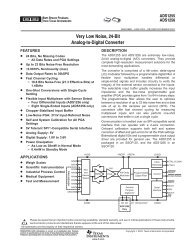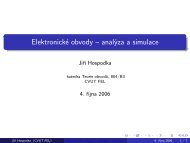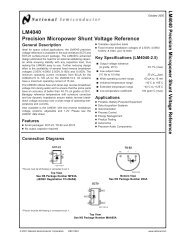LTC2410 24-Bit No Latency âΣTM ADC with Differential Input and ...
LTC2410 24-Bit No Latency âΣTM ADC with Differential Input and ...
LTC2410 24-Bit No Latency âΣTM ADC with Differential Input and ...
You also want an ePaper? Increase the reach of your titles
YUMPU automatically turns print PDFs into web optimized ePapers that Google loves.
<strong>LTC<strong>24</strong>10</strong>APPLICATIO S I FORATIOU W U Umentation amplifier is used at low gain. If this amplifier isused at a gain of 10, the gain error is only 10ppm <strong>and</strong> inputreferred noise is reduced to 0.1µV RMS . The buffer stagescan also be configured to provide gain of up to 50 <strong>with</strong> highgain stability <strong>and</strong> linearity.Figure 49 shows an example of a single amplifier used toproduce single-ended gain. This topology is best used inapplications where the gain setting resistor can be madeto match the temperature coefficient of the strain gauges.If the bridge is composed of precision resistors, <strong>with</strong> onlyone or two variable elements, the reference arm of thebridge can be made to act in conjunction <strong>with</strong> the feedbackresistor to determine the gain. If the feedback resistor isincorporated into the design of the load cell, using resistorswhich match the temperature coefficient of the loadcellelements, good results can be achieved <strong>with</strong>out theneed for resistors <strong>with</strong> a high degree of absolute accuracy.The common mode voltage in this case, is again a functionof the bridge output. <strong>Differential</strong> gain as used <strong>with</strong> a 350Ωbridge is A V = (R1+ R2)/(R1+175Ω). Common mode gainis half the differential gain. The maximum differentialsignal that can be used is 1/4 V REF , as opposed to 1/2 V REFin the 2-amplifier topology above.Remote Half Bridge InterfaceAs opposed to full bridge applications, typical half bridgeapplications must contend <strong>with</strong> nonlinearity in the bridgeoutput, as signal swing is often much greater. Applicationsinclude RTD’s, thermistors <strong>and</strong> other resistive elementsthat undergo significant changes over their span. Forsingle variable element bridges, the nonlinearity of the halfbridge output can be eliminated completely; if the referencearm of the bridge is used as the reference to the <strong>ADC</strong>,as shown in Figure 50. The <strong>LTC<strong>24</strong>10</strong> can accept inputs upto 1/2 V REF . Hence, the reference resistor R1 must be atleast 2x the highest value of the variable resistor.In the case of 100Ω platinum RTD’s, this would suggest avalue of 800Ω for R1. Such a low value for R1 is notadvisable due to self-heating effects. A value of 25.5k isshown for R1, reducing self-heating effects to acceptablelevels for most sensors.The basic circuit shown in Figure 50 shows connectionsfor a full 4-wire connection to the sensor, which may belocated remotely. The differential input connections willreject induced or coupled 60Hz interference, however, the1 <strong>Input</strong> referred noise for A V = 34 for approximately 0.05µV RMS , whereas at a gain of 50, it would be0.048µV RMS .5V REF5V0.1µF350ΩBRIDGE1RN11632+–81U1A415 146 11 7 10238 94135 1223–+5V8U2A40.1µF10.1µFV3 CCREF + 12SDO4REF – 13SCK5IN +2CS1165–+U1B765–+U2B76IN –<strong>LTC<strong>24</strong>10</strong>GNDF O141, 7, 8, 9,10, 15, 16RN1 = 5k × 8 RESISTOR ARRAYU1A, U1B, U2A, U2B = 1/2 LTC1051<strong>24</strong>10 F4838Figure 48. Using Autozero Amplifiers to Reduce <strong>Input</strong> Referred <strong>No</strong>ise






